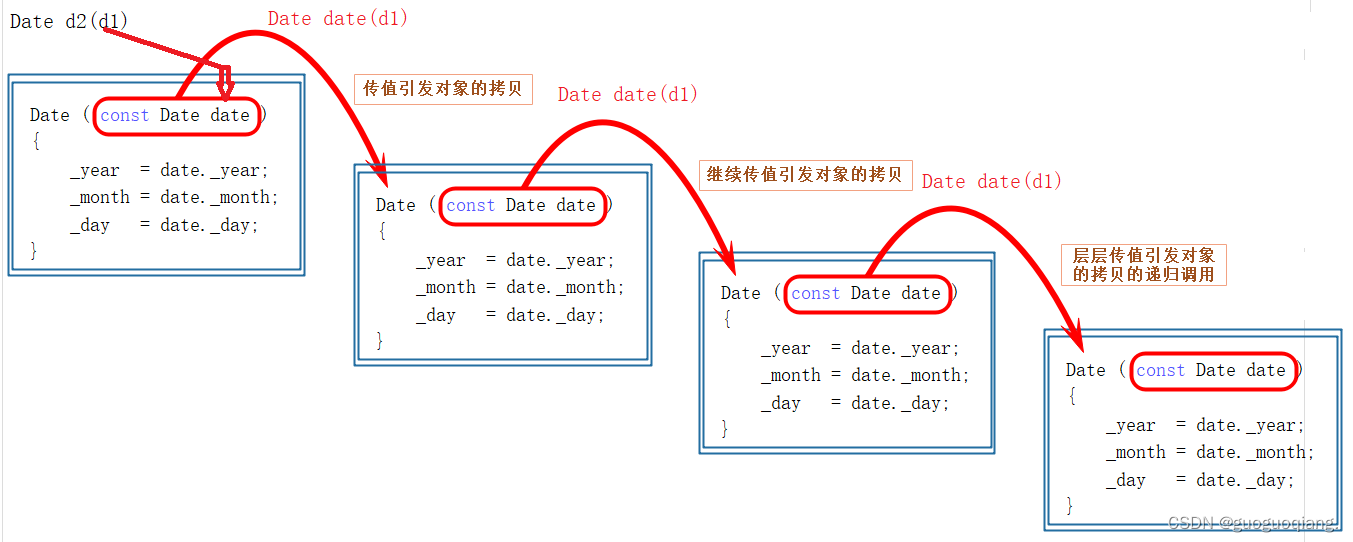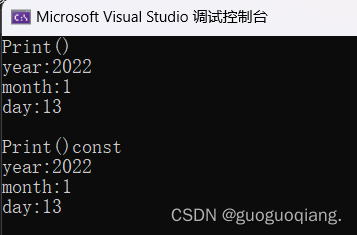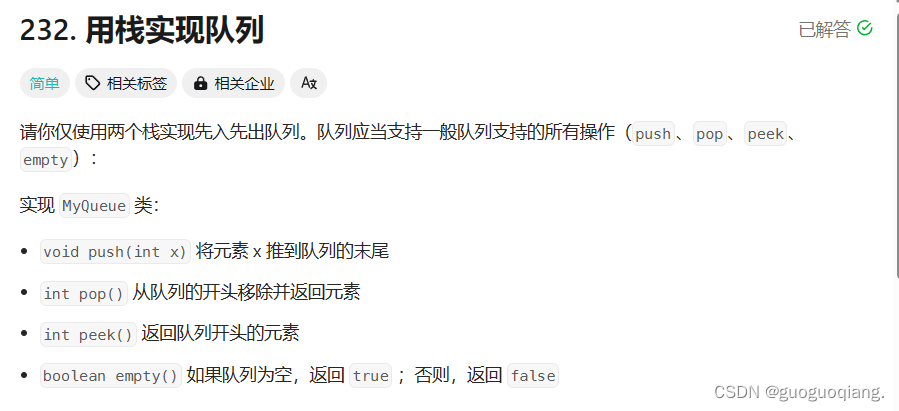
🔥个人主页:guoguoqiang. 🔥专栏:我与C++的爱恋

先来回顾一下,上一节的内容并且通过上次的内容来做一道oj题。
https://leetcode.cn/problems/implement-queue-using-stacks/
class MyQueue {
private:stack<int> inStack, outStack;void in2out() {while (!inStack.empty()) {outStack.push(inStack.top());inStack.pop();}}public:MyQueue() {}void push(int x) {inStack.push(x);}int pop() {if (outStack.empty()) {in2out();}int x = outStack.top();outStack.pop();return x;}int peek() {if (outStack.empty()) {in2out();}return outStack.top();}bool empty() {return inStack.empty() && outStack.empty();}
};
一、拷贝构造函数
拷贝构造函数可以理解为特殊的构造函数。
拷贝构造函数:只有单个形参,该形参是对本类类型对象的引用(一般常用const修饰),在用已存在的类类型对象创建新对象时由编译器自动调用。
拷贝构造函数也是特殊的成员函数,其特征如下:
- 拷贝构造函数是构造函数的一个重载形式。
- 拷贝构造函数的参数只有一个且必须是类类型对象的引用,使用传值方式编译器直接报错,因为会引发无穷递归调用。
class Date
{
public:
Date(int year = 1900, int month = 1, int day = 1)
{
_year = year;
_month = month;
_day = day;
}
// Date(const Date& d) // 正确写法
Date(const Date& d) // 错误写法:编译报错,会引发无穷递归
{
_year = d._year;
_month = d._month;
_day = d._day;
}
private:
int _year;
int _month;
int _day;
};
int main()
{
Date d1;
Date d2(d1);
return 0;
}

3. ==若未显式定义,编译器会生成默认的拷贝构造函数。 ==
默认的拷贝构造函数对象按内存存储按字节序完成拷贝,这种拷贝叫做浅拷贝,或者值拷贝。
class Time
{
public:
Time()
{
_hour = 1;
_minute = 1;
_second = 1;
}
Time(const Time& t)
{
_hour = t._hour;
_minute = t._minute;
_second = t._second;
cout << "Time::Time(const Time&)" << endl;
}
private:
int _hour;
int _minute;
int _second;
};
class Date
{
private:
// 基本类型(内置类型)
int _year = 1970;
int _month = 1;
int _day = 1;
// 自定义类型
Time _t;
};
int main()
{
Date d1;
// 用已经存在的d1拷贝构造d2,此处会调用Date类的拷贝构造函数
// 但Date类并没有显式定义拷贝构造函数,则编译器会给Date类生成一个默认的拷贝构
造函数
Date d2(d1);
Date d3=d1;
return 0;
}
在编译器生成的默认拷贝构造函数中,内置类型是按照字节方式直接拷贝的,而自定义类型是调用其拷贝构造函数完成拷贝的。
4. 编译器生成的默认拷贝构造函数已经可以完成字节序的值拷贝了,但是在需要开空间的拷贝时必须深拷贝。
typedef int DataType;
class Stack
{
public:
Stack(size_t capacity = 10)
{
_array = (DataType*)malloc(capacity * sizeof(DataType));
if (nullptr == _array)
{
perror("malloc申请空间失败");
return;
}
_size = 0;
_capacity = capacity;
}
void Push(const DataType& data)
{
// CheckCapacity();
_array[_size] = data;
_size++;
}
~Stack()
{
if (_array)
{
free(_array);
_array = nullptr;
_capacity = 0;
_size = 0;
}
}
private:
DataType *_array;
size_t _size;
size_t _capacity;
};
int main()
{
Stack s1;
s1.Push(1);
s1.Push(2);
s1.Push(3);
s1.Push(4);
Stack s2(s1);
return 0;
}
比如在上述代码中,s1和s2共用一段空间,在销毁时s2先销毁调用析构函数,以及将空间释放了,s1不知道,到s1销毁时,会将空间再释放一次,一次内存空间多次释放,肯定会造成程序崩溃。
插入、删除数据会互相影响。
** 1.类中如果没有涉及资源申请时,拷贝构造函数是否写都可以,如Date;一旦涉及到资源申请时,则拷贝构造函数是一定要写的,否则就是浅拷贝。
2. 如果都是自定义类型成员,内置类型成员没有指向资源,使用默认生成的拷贝构造函数就可以
3.一般情况下,不需要显示写析构函数,就不需要写拷贝构造函数
4.如果内部有指针或者一些值指向资源,需要显示写析构释放,通常就要显示写构造函数完成深拷贝,如Stack,Queue,List**
5. 拷贝构造函数典型调用场景:
使用已存在对象创建新对象
函数参数类型为类类型对象
函数返回值类型为类类型对象
class Date
{
public:
Date(int year, int minute, int day)
{
cout << "Date(int,int,int):" << this << endl;
}
Date(const Date& d)
{
cout << "Date(const Date& d):" << this << endl;
}
~Date()
{
cout << "~Date():" << this << endl;
}
private:
int _year;
int _month;
int _day;
};
Date Test(Date d)
{
Date temp(d);
return temp;
}
int main()
{
Date d1(2022,1,13);
Test(d1);
return 0;
}

第一个析构函数是销毁temp,第二个析构函数是用来销毁func中的参数,第三个析构函数是用来销毁d1;
为了提高程序效率,一般对象传参时,尽量使用引用类型,返回时根据实际场景,能用引用尽量使用引用
二、赋值运算符重载
看到这个,大家有没有想到以前出现过的内容
函数重载:支持函数名相同,参数不同的函数,与本次学习的可以同时使用。
1.运算符重载
C++为了增强代码的可读性引入了运算符重载,运算符重载是具有特殊函数名的函数,也具有其返回值类型,函数名字以及参数列表,其返回值类型与参数列表与普通的函数类似。
函数名字为:关键字operator后面接需要重载的运算符符号。
函数原型:返回值类型 operator操作符(参数列表)
不能通过连接其他符号来创建新的操作符:比如operator@
重载操作符必须有一个类类型参数
用于内置类型的运算符,其含义不能改变,例如:内置的整型+,不 能改变其含义
作为类成员函数重载时,其形参看起来比操作数数目少1,因为成员函数的第一个参数为隐
藏的this
.* :: sizeof ?: . 注意以上5个运算符不能重载。
*.可以帮助我们调用成员函数指针
//全局的operator==
class Date
{
public:Date(int year = 1900, int month = 1, int day = 1){_year = year;_month = month;_day = day;}//private:int _year;int _month;int _day;
};
bool operator==(const Date& d1, const Date& d2)
{return d1._year == d2._year&& d1._month == d2._month&& d1._day == d2._day;
}
void Test()
{Date d1(2018, 9, 26);Date d2(2018, 9, 27);cout<<operator==(d1,d2)<<endl;cout << (d1 == d2) << endl;
}
int main() {Test();return 0;
}

运算符重载为全局的就需要成员变量是公有的,那该如何保证封装性呢?
1.提供这些成员的get和set
2.通过友元解决
3.重载成成员函数
class Date
{
public:Date(int year = 1900, int month = 1, int day = 1) {_year = year;_month = month;_day = day;}Date(const Date& d) {_year = d._year;_month = d._month;_day = d._day;}// bool operator==(Date* this, const Date& d2)// 这里需要注意的是,左操作数是this,指向调用函数的对象bool operator==(const Date& d2){return _year == d2._year&& _month == d2._month&& _day == d2._day;}
private:int _year;int _month;int _day;
};
int main() {Date d1(2019, 8, 8);Date d2(d1);Date d3(2024, 4, 18);cout << (d3.operator==(d1)) << endl;cout << (d1 == d2) << endl;return 0;
}

2.赋值运算符的重载
- 赋值运算符重载格式==
参数类型:const T&,传递引用可以提高传参效率
返回值类型:T&,返回引用可以提高返回的效率,有返回值目的是为了支持连续赋值
检测是否自己给自己赋值
返回*this :要复合连续赋值的含义
class Date
{
public:Date(int year = 1900, int month = 1, int day = 1){_year = year;_month = month;_day = day;}Date(const Date& d){_year = d._year;_month = d._month;_day = d._day;}Date& operator=(const Date& d)//返回值为了支持连续赋值,保持运算符的特性{if (this != &d){_year = d._year;_month = d._month;_day = d._day;}return *this;}
private:int _year;int _month;int _day;
};
虽然引用返回可以减少一次拷贝,但是出了函数作用,返回对象还在才能用引用返回。
a.返回对象生命周期到了会析构,传值返回
b.返回对象生命周期没到,不会析构,传引用返回。
2.赋值运算符只能重载成类的成员函数不能重载成全局函数
class Date
{
public:
Date(int year = 1900, int month = 1, int day = 1)
{
_year = year;
_month = month;
_day = day;
}
int _year;
int _month;
int _day;
};
// 赋值运算符重载成全局函数,注意重载成全局函数时没有this指针了,需要给两个参数
Date& operator=(Date& left, const Date& right)
{
if (&left != &right)
{
left._year = right._year;
left._month = right._month;
left._day = right._day;
}
return left;
}
// 编译失败:
// error C2801: “operator =”必须是非静态成员
原因:赋值运算符如果不显式实现,编译器会生成一个默认的。此时用户再在类外自己实现一个全局的赋值运算符重载,就和编译器在类中生成的默认赋值运算符重载冲突了,故赋值运算符重载只能是类的成员函数。
3. 用户没有显式实现时,编译器会生成一个默认赋值运算符重载,以值的方式逐字节拷贝。(跟拷贝构造类似)
class Time
{
public:
Time()
{
_hour = 1;
_minute = 1;
_second = 1;
}
Time(const Time& t)
{
_hour = t._hour;
_minute = t._minute;
_second = t._second;
cout << "Time::Time(const Time&)" << endl;
}
private:
int _hour;
int _minute;
int _second;
};
class Date
{
private:
// 基本类型(内置类型)
int _year = 1970;
int _month = 1;
int _day = 1;
// 自定义类型
Time _t;
};
int main()
{
Date d1;
Date d2(d1);
Date d3=d1;
return 0;
如果类中未涉及到资源管理,赋值运算符是否实现都可以;一旦涉及到资源管理则必须要实现
3.前置++和后置++重载
class Date
{
public:
Date(int year = 1900, int month = 1, int day = 1)
{
_year = year;
_month = month;
_day = day;
}
// 前置++:返回+1之后的结果
// 注意:this指向的对象函数结束后不会销毁,故以引用方式返回提高效率
Date& operator++()
{
*this += 1;
return *this;
}
//后置++
Date operator++(int)
{
Date temp(*this);
*this += 1;
return temp;
}
private:
int _year;
int _month;
int _day;
};
int main()
{
Date d;
Date d1(2022, 1, 13);
d = d1++; // d: 2022,1,13 d1:2022,1,14
d = ++d1; // d: 2022,1,15 d1:2022,1,15
return 0;
}
4.函数重载和运算符重载
函数重载:可以让函数名相同,参数不同的函数存在。
运算符重载:让自定义类型可以用运算符,并且控制运算符的行为增强可读性。
多个同一运算符重载可以构成函数重载。
三、const成员
将const修饰的“成员函数”称之为const成员函数,const修饰类成员函数,实际修饰该成员函数隐含的this指针,表明在该成员函数中不能对类的任何成员进行修改。

class Date
{
public:
Date(int year, int month, int day)
{
_year = year;
_month = month;
_day = day;
}
void Print()
{
cout << "Print()" << endl;
cout << "year:" << _year << endl;
cout << "month:" << _month << endl;
cout << "day:" << _day << endl << endl;
}
void Print() const//**const**Date const *this
{
cout << "Print()const" << endl;
cout << "year:" << _year << endl;
cout << "month:" << _month << endl;
cout << "day:" << _day << endl << endl;
}
private:
int _year; // 年
int _month; // 月
int _day; // 日
};
void Test()
{
Date d1(2022,1,13);
d1.Print();
const Date d2(2022,1,13);
d2.Print();
}
上述代码中 const 本质就是逻辑不闭环,const修饰*this,本质改this的类型。

const对象不能调用非const成员函数
const成员函数内不能调用其它的非const成员函数
上述两个 是权限的放大
非const对象可以调用const成员函数
非const成员函数内可以调用其它的const成员函数
这两个是权限的缩小可以调用。
总结一下:只读函数(内部不涉及修改生成)可以加const
本篇内容到此结束,谢谢大家观看!!!


】)
--fixtrue固件)

)
)
)
算法【随机近似】)

)

)
配置消息队列)






